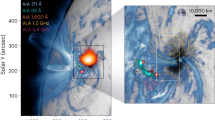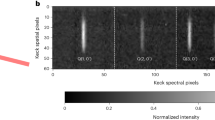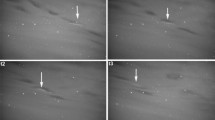Abstract
Jupiter's aurora is the most powerful in the Solar System1. It is powered largely by energy extracted from planetary rotation2, although there seems also to be a contribution from the solar wind3,4. This contrasts with Earth's aurora, which is generated through the interaction of the solar wind with the magnetosphere. The major features of Jupiter's aurora (based on far-ultraviolet5,6,7, near-infrared8,9 and visible-wavelength10 observations) include a main oval that generally corotates with the planet and a region of patchy, diffuse emission inside the oval on Jupiter's dusk side. Here we report the discovery of a rapidly evolving, very bright and localized emission poleward of the northern main oval, in a region connected magnetically to Jupiter's outer magnetosphere. The intensity of the emission increased by a factor of 30 within 70 s, and then decreased on a similar timescale, all captured during a single four-minute exposure. This type of flaring emission has not previously been reported for Jupiter (similar, but smaller, transient events have been observed at Earth), and it may be related directly to changes in the solar wind.
This is a preview of subscription content, access via your institution
Access options
Subscribe to this journal
Receive 51 print issues and online access
$199.00 per year
only $3.90 per issue
Buy this article
- Purchase on Springer Link
- Instant access to full article PDF
Prices may be subject to local taxes which are calculated during checkout



Similar content being viewed by others
References
Bhardwaj, A. & Gladstone, G. R. Auroral emissions of the giant planets. Rev. Geophys. 38, 295–353 (2000).
Hill, T. W., Dessler, A. J. & Goertz, C. K. in Physics of the Jovian Magnetosphere (ed. Dessler, A. J.) 353–394 (Cambridge Univ. Press, Cambridge, 1983).
Desch, M. D. & Barrow, C. H. Direct evidence for solar wind control of Jupiter's hectometer-wavelength radio emission. J. Geophys. Res. 89, 6819–6823 (1984).
Baron, R. L., Owen, T., Connerney, J. E. P., Satoh, T. & Harrington, J. Solar wind control of Jupiter's H+3 auroras. Icarus 120, 437–442 (1996).
Clarke, J. T. et al. Far-ultraviolet imaging of Jupiter's aurora and the Io “footprint”. Science 274, 404–409 (1996).
Clarke, J. T. et al. Hubble Space Telescope imaging of Jupiter's UV aurora during the Galileo orbiter mission. J. Geophys. Res. 103, 20217–20236 (1998).
Prangé, R. et al. Detailed study of FUV Jovian auroral features with the post-COSTAR HST faint object camera. J. Geophys. Res. 103, 21095–20215 (1998).
Connerney, J. E. P., Baron, R., Satoh, T. & Owen, T. Images of excited H+3 at the foot of the Io flux tube in Jupiter's atmosphere. Science 262, 1035–1038 (1993).
Satoh, T. & Connerney, J. E. P. Jupiter's H+3 emissions viewed in corrected jovimagnetic coordinates. Icarus 141, 236–252 (1999).
Vasavada, A. R. et al. Jupiter's visible aurora and Io footprint. J. Geophys. Res. 104, 27133–27142 (1999).
Connerney, J. E. P., Acuña, M. H., Ness, N. F. & Satoh, T. New models of Jupiter's magnetic field constrained by the Io flux tube footprint. J. Geophys. Res. 103, 11929–11939 (1998).
Khurana, K. K. Euler potential models of Jupiter's magnetospheric field. J. Geophys. Res. 102, 11295–11306 (1997).
Ogino, T., Walker, R. J. & Kivelson, M. G. A global magnetohydrodynamic simulation of the jovian magnetosphere. J. Geophys. Res. 103, 225–235 (1998).
Stone, J. M. & Norman, M. L. ZEUS-2D: A radiation magnetohydrodynamics code for astrophysical flows in two space dimensions. I. The hydrodynamic algorithms and tests. Astrophys. J. Suppl. Ser. 80, 753–790 (1992).
Gosling, J. T. & Riley, P. The acceleration of slow coronal mass ejections in the high-speed solar wind. Geophys. Res. Lett. 23, 2867–2870 (1996).
McComas, D. J. et al. Solar wind electron proton alpha monitor (SWEPAM) for the Advanced Composition Explorer. Space Sci. Rev. 86, 563–612 (1998).
Intriligator, D. S. & Wolfe, J. H. in Jupiter: Studies of the Interior, Atmosphere, Magnetosphere, and Satellites (ed. Gehrels, T.) 848–869 (Univ. Arizona Press, Tucson, 1976).
Craven, J. D., Frank, L. A., Russell, C. T., Smith, E. J. & Lepping, R. P. in Solar Wind–Magnetosphere Coupling (eds Kamide, Y. & Slavin, J. A.) 367–380 (Terra Scientific, Tokyo, 1986).
Zhou, X. & Tsurutani, B. T. Rapid intensification and propagation of the dayside aurora: Large scale interplanetary pressure pulses (fast shocks). Geophys. Res. Lett. 26, 1097–1100 (1999).
Sandholt, P. E. et al. Cusp/cleft auroral activity in relation to solar wind dynamic pressure, interplanetary magnetic field Bz and By. J. Geophys. Res. 99, 17323–17342 (1994).
Acknowledgements
We gratefully acknowledge discussions with B. T. Tsurutani and J. L. Burch and the support of the Space Telescope Science Institute.
Author information
Authors and Affiliations
Corresponding author
Supplementary information
Rights and permissions
About this article
Cite this article
Waite, J., Gladstone, G., Lewis, W. et al. An auroral flare at Jupiter. Nature 410, 787–789 (2001). https://doi.org/10.1038/35071018
Received:
Accepted:
Issue Date:
DOI: https://doi.org/10.1038/35071018
Comments
By submitting a comment you agree to abide by our Terms and Community Guidelines. If you find something abusive or that does not comply with our terms or guidelines please flag it as inappropriate.



